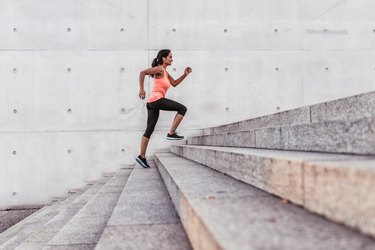
Running has plenty of positive side effects: It builds strength, enhances mood and quickens the metabolism. But for all the benefits of running, there are also dangers that come with overworking and overstraining muscles, particularly in the calf region. Fortunately, there are ways to reduce and treat calf pain when running — from stretching before and after a jog to drinking plenty of water and wearing the right footwear.
What Is Calf Pain?
Video of the Day
To understand what causes calf pain, it's important to first understand the area where calf pain originates. The calf is composed of two muscles: the gastrocnemius and the soleus. They join at the Achilles tendon, which is connected to the heel bone. When either of these muscles is overstretched or torn, it's referred to as calf strain.
Video of the Day
There are a few telltale signs that you may be experiencing calf strain. The first is that you might feel a pop, snap or tear in your calf. You may also find that your calf is stiff or weak when you walk or that it's difficult to rise up on your toes. There may also be bruising on your calf for one or two days.
Causes of Calf Pain
Calf pain occurs when muscles suddenly contract, causing a cramp. There are a few things that may trigger cramping, including dehydration, mineral deficiency or strenuous exercise like running. Overusing the calf muscles during physical activity can lead to a strain or Achilles tendinitis, which occurs when the Achilles tendon becomes inflamed.
Read more: How to Treat Sore Calves
How to Prevent Sore Calves
The good news is that calf pain can be reduced or prevented by taking certain precautions. Stretching before and after a run can strengthen calf muscles and prevent calf tightness while you're exercising. For a thorough stretch, practicing yoga can help target the right muscles for preventing calf strain.
It's critical to make sure you don't overexert yourself when exercising by running too far or running up a hill that's too steep. Build up little by little if you're starting something new, like training for a long race. Drinking water helps as well. The Better Health Channel recommends drinking plenty of water before, during and after exercise to prevent cramps.
If your calves hurt when running, make sure you're wearing the proper shoes. NHS recommends walking in comfortable shoes when you're healing from a strained calf, in addition to wearing shoes with a thicker or higher heel to lessen the stretch on the calf.
Calf Pain Treatment
Calf pain can be treated in a number of ways. If you have a cramp, it helps to gently stretch or massage the muscle. If you're experiencing a strain or Achilles tendinitis, you can use RICE treatment:
- REST the leg.
- ICE the painful part of the leg for 20 minutes with an ice pack or bag of frozen peas.
- COMPRESS the painful area with a bandage, unless the pain gets worse, in which case, loosen the bandage.
- ELEVATE the lower leg while sitting or lying down.
To relieve pain and bring down swelling, you can also take nonsteroidal anti-inflammatory drugs, such as aspirin or ibuprofen, or stretch the calf by doing heel raises. It's best not to return to running until the ankle and knee are functioning well and the calf is strong.
Is this an emergency? If you are experiencing serious medical symptoms, please see the National Library of Medicine’s list of signs you need emergency medical attention or call 911.